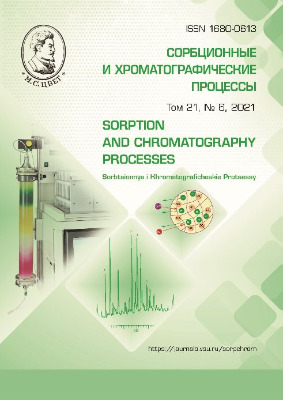Regularities of the formation of dimeric complexes by exo- and endoinulinases molecules. Change in the composition of potential binding sites with charged and hydrophobic carries for their immobilization
Abstract
Inulinase (EC 3.2.1.80 and 3.2.1.7) belong to the family of glycoside hydrolases and are an important group of industrial enzymes. In the literature, there are conflicting data on the supramolecular organization of the enzymes of this group, therefore there is a need for its systematic study.
The aim of this study was the identification of differences in the composition of conserved sequences within groups of inulinases with exo- and endo-activity, the search on the surfaces of molecules for potential binding sites with matrices of charged and hydrophobic carriers for adsorption immobilization, and study of the patterns of changes in their composition during dimerization.
Exoinulinases from Aspergillus awamori (CAC44220.1), A. ficuum (ADM21204.1), A. niger (EHA22512.1), Bacillus licheniformis (AGR40655.1), Geobacillus stearothermophilus (BAC45010.1) and Paenibacillus polymyxa (AHN08014.1) and endoinulinase from A. fumigatus (XP_748286), A. niger (AAN64131.1, ABB59681.1, EHA19510), Fusarium oxysporum (ANY59682.1) and Kluyveromyces marxianus (CAA02437.1) were used as the object of the study. Based on their amino acid sequences (taken from the NCBI database), the spatial structures of the enzymes presented in the research were modelled. Dimeric complexes of enzymes were obtained using the Zdock, ClusPro, GRAMM_X, HEX, and SwarmDock programs. After dimerization, changes in the composition of amino acids on the surface of the studied enzymes, affecting the identified conservative sequences, were observed.
The analysis of the inulinases presented in the study showed the uneven distribution of amino acid residues on their surface with the formation of local accumulations. It was shown that for the immobilization of exoinulinases from A. ficuum (ADM21204.1), A. niger (EHA22512.1), A. awamori (CAC44220.1), endoinulinases from A. niger (ABB59681.1 and EHA19510.1) and inulinase from A. fumigatus (XP_748286.1) negatively charged carriers, which probably will bind to sites located in the region of the non-catalytic C-terminal domain are promising. Monomer molecules of all inulinases discussed in this study were characterized by the presence of accumulations of hydrophobic amino acid residues in the immediate vicinity of the active site, which may indicate a probable significant loss of activity upon immobilization of these enzymes on hydrophobic carriers.
During the dimerization of inulinase macromolecules, a change in the composition of the accumulations of charged and hydrophobic residues was observed. This could occur both due to the transition of amino acids from the surface to the inner part of the protein and vice versa, and due to a change in the distance between them. Most of the inulinases presented in this study were characterized by the predominance of transitions of charged and hydrophobic residues from the surface to the inner part of the molecule and vice versa.
Downloads
References
Basso A., Spizzo P., Ferrario V., Knapic L. et al., Biotechnol. Prog., 2010, Vol. 26, No 2, pp. 397-405.
Nagem R.A., Rojas A.L., Golubev A.M., Korneeva O.S. et al., J. Mol. Biol., 2004, Vol. 344, No 11, pp. 471-480.
Lefebvre R., Vasseur J., Backoula E., Couillerot J.P., Can J Bot., 1992, Vol. 70, pp. 1897-1902.
Mishra S.C., Sen S.P.K., Mater Organ-ismen, 1987, Vol. 22, pp. 127-138.
Neagu C., Bahrim G., Innov Rom Food Biotechnol., 2011, Vol. 9, pp. 1-11.
Wang L., Huang Y., Long X., Meng X. et al., J Appl Microbiol., 2011, Vol. 111, pp. 1371-1380.
Pesso A., Vitolo M., Biotechnol. Techn., 1997, Vol. 11, P. 421.
Uusitupa M.I., The American journal of clinical nutrition, 1994, Vol. 59, pp. 753-757.
Sievenpiper J.L., de Souza R.J., Coz-ma A.I., Chiavaroli L. et al., Current Opinion in Lipidology, 2014, Vol. 25, pp. 8-19.
Singh R.S., Chauhan K., Singh R.P., Plant Biotechnology: recent advancements and developments, 2017, pp. 189-211.
Gibson G.R., The Journal of nutrition, 1999, Vol. 129, pp. 1438-1441.
Pandey A., Soccol C.R., Selvakumar P., Soccol V.T. et al., Appl. Biochem. Biotechnol., 1999, Vol. 81, pp. 35-52.
Holyavka M.G., Kondratyev M.S., Samchenko A.A., Kabanov A.V. et al., Computers in biology and medicine, 2016, Vol. 71, pp. 198-204.
Kovaleva T.A., Holyavka M.G., Takha A.S., Sorbtsionnye i khromatograficheskie protsessy, 2007, Vol. 7, No 5, pp. 804-810.
Arand M., Golubev A.M., Neto B.J.R., Polikarpov I. et al. Режим доступа: https://www.ncbi.nlm.nih.gov/protein/CAC44220.1 (дата обращения: 24.07.2018)
Chen X.-M., Xu X.-M., Jin Z.-Y. Ре-жим доступа: https://www.ncbi.nlm.nih.gov/protein/ADM21204.1 (дата обращения: 24.07.2018)
Andersen M.R., Salazar M.P., Schaap P.J., van de Vondervoort P.J. et al., Genome research, 2011, Vol. 21, pp. 885-897.
Lu W.-D. Режим доступа: https://www.ncbi.nlm.nih.gov/protein/AGR40655.1 (дата обращения: 24.07.2018)
Tsujimoto Y., Watanabe A., Nakano K., Watanabe K. et al., Appl. Microbiol. Biotechnol., 2003, Vol. 62, pp. 180-185.
Gao J., Xu Y.Y., Yang H.M., Xu H. et al., Appl Biochem Biotechnol., 2014, Vol. 173, pp. 1419-1430.
Nierman W.C., Pain A., Anderson M.J., Wortman J.R., Kim H.S. et al., Nature, 2005, Vol. 438(7071), pp. 1151-1156.
Monod M., Mouyna I., Mulligan S., Murphy L. et al., Nature, 2006, Vol. 439(7075), p. 502.
Wang J.-H., Teng D., Yao Y. Режим доступа: https://www.ncbi.nlm.nih.gov/protein/AAN64131.1 (дата обращения: 24.07.2018)
Yuan X.L., Goosen C., Kools H., van der Maarel M.J. et al., Microbiology, 2006, Vol. 152, pp. 3061-3073.
Andersen M.R., Salazar M.P., Schaap P.J., van de Vondervoort P.J. et al., Genome Res., 2011, Vol. 21, pp. 885-897.
Pouyez J., Mayard A., Vandamme A.M., Roussel G. et al., Biochimie, 2012, Vol. 94, pp. 2423-2430.
Abdullatypov A.V., Kondratyev M.S., Kholyavka M.G., Artyukhov V.G., Biophys-ics, 2016, Vol. 61, pp. 565-571.
Yang J.-K., Zhang J.-W., Mao L., You X., Xiong W. Режим доступа: https://www.ncbi.nlm.nih.gov/protein/ANY59682 (дата обращения: 24.07.2018)
Chapman J.W., Musters W., Rouwenhorst R.J., Toschka H.Y., Verbakel, J.M. Режим доступа: https://www.ncbi.nlm.nih.gov/protein/CAA02437.1 (дата обращения: 24.07.2018)







